In a hot dry spring many birds and animals are struggling to survive even here in suburbia. However, gardens large and small can help wildlife survive in difficult circumstances, especially when gardens are planted with indigenous (native) plants that provide food and shelter.
Eating and collecting food for larvae or offspring take up much of any animal or bird’s energy and time. It really warms my heart to see the plants in our garden providing food for a diversity of creatures.

A Brown-hooded Kingfisher with a freshly caught cricket
Insectivorous birds, many small reptiles, spiders and insects themselves prey on insects and other creatures and are part of the circle of life, and so using pesticides in our gardens should be avoided. Using pesticides interrupts the food chain – not only does poison remove food sources from birds and animals that we claim to cherish, but also non-target species can be poisoned from eating poisoned prey. Even if they are not killed outright, they can be weakened and become ill, ultimately resulting in a slow death.

Moth and butterfly-friendly gardens host also their larval forms, that is caterpillars, which in turn provide food for many birds and other creatures
Suburban and urban spaces can provide sustenance and sanctuary for many animals, and it would be wonderful if more people with gardens and balconies provide plants and habitat for wild animals and birds. Imagine the mosaic of sanctuaries that would ensue!
It is not necessary to be a purist; planting up wildlife-friendly corners or sections of the garden or else mixed borders incorporating native food plants would make a significant contribution. Native plants are often hardy and water-wise too, making for a less resource-greedy garden that gives back as much as it takes in. When rain is scarce and temperatures are high, planting more robust native plants that do not need lots of water, fertiliser or pampering makes a lot of sense, and these plants can flourish without the gardener being tempted to use pesticides.

An African Emerald Cuckoo eating a Processionary Caterpillar
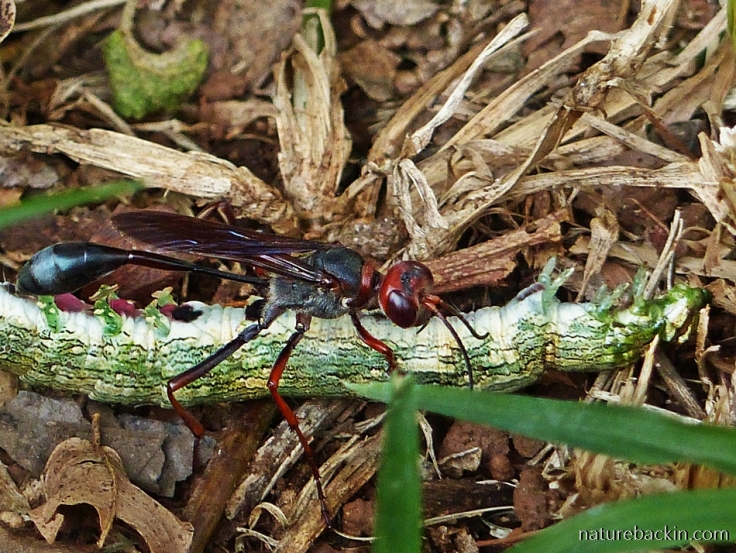
A thread-waisted wasp transporting a large caterpillar to provision its nest where it will lay its eggs
Bird feeders stocked with commercial bird seed can be used as a supplement when times are hard, but birds need shelter, nesting materials and nesting sites too. Many plants provide all this and food too, and they don’t need stocking and cleaning, are less of a focus for competitive behaviour than bird feeders sometimes are, and unlike bird feeders they are not a potential source of moulds, bacteria and viruses, which are all risks associated with bird feeders.
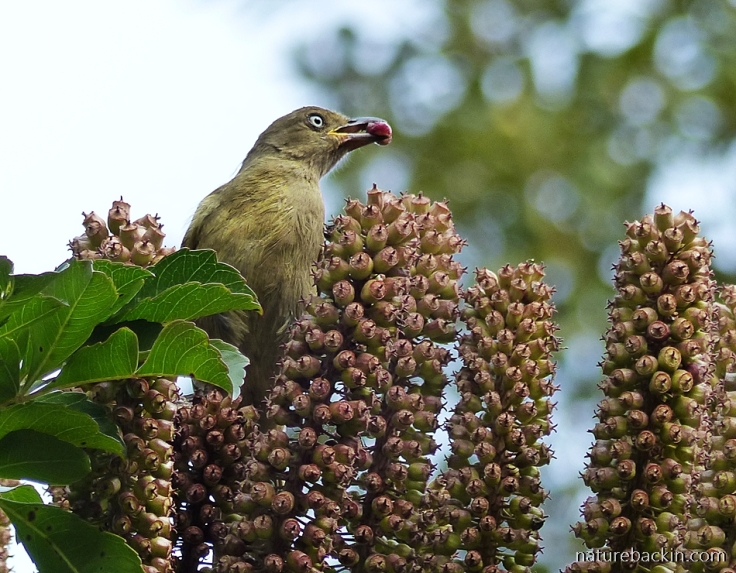
A Sombre Greenbul enjoying fruit from a Cabbage Tree
There are many attractive native plants that bear fruit and they can provide for a diversity of creatures across the seasons. Seedeaters should not be forgotten either. Native grasses provide an unexplored source of richness for gardens and grasses can be used to good effect in many borders and awkward areas of the garden, as well as in pots on decks, patios and balconies.

A Swee Waxbill finding seeds on native grasses growing at the base of a Copper-stem Corkwood (Commiphora harveyi)
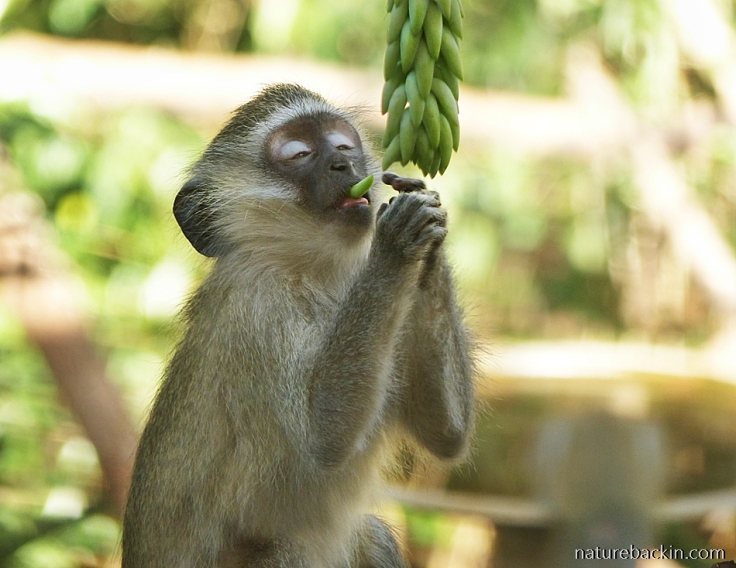
Peeking through a window blind I secretly photographed this young Vervet Monkey carefully savouring a succulent leaf from a hanging stem of a potted Donkey’s Tail (Sedum Morganinum). I was given this exotic plant as a gift and I have been surprised to see it favoured by a few of the visiting monkeys. Although not a native plant, it serves as a reminder that pot plants too can be food plants for animals and birds
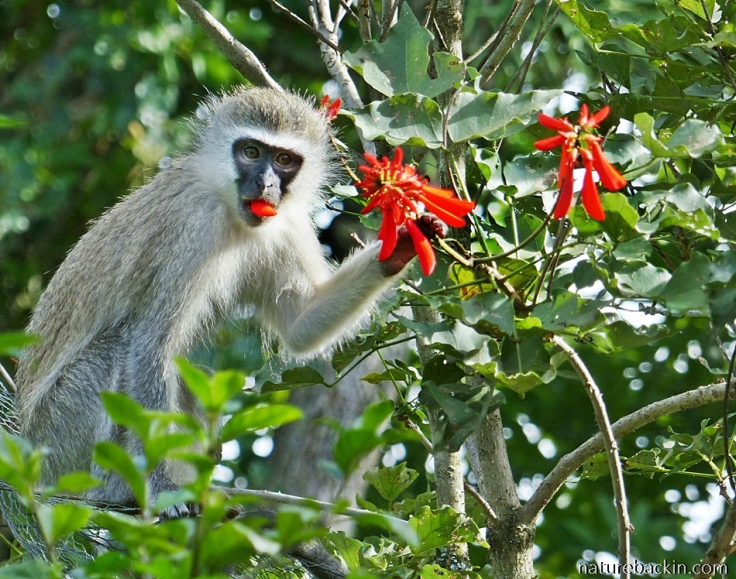
Although tricky to photograph in harsh sunshine, I rather like this image of a Vervet Monkey eating the scarlet petals of a flower of a Dwarf Coral-Tree (Erythrina humeana)
Flowers are important sources of food eaten whole or petal by petal and also because of the nectar and pollen that they provide. Although honey bees get the most press when it comes to pollinating plants, many flies and other insects as well as birds play significant roles as pollinators too.

Honey bees busily collecting pollen from a Snake Lily (Scadoxus puniceus)

A female Double-collared Sunbird feeding on nectar from a Fence Aloe (Aloiampelos tenuior)
The day this post is scheduled to be published, we will still be away on our holiday and stopping over on our way home at Camdeboo National Park near Graaff-Reinet. When we booked our trip we knew there was an ongoing drought in the Eastern Cape and the Karoo, but we had little idea then that the drought would bite as hard as it has.
In the past weeks Graaff-Reinet’s water supply dam, the Nqweba dam, which is located in the Camdeboo National Park, became completely dry – it is now an expanse of dry mud strewn with the dehydrated remains of rotted fish. The humanitarian organisation the Gift of the Givers is providing emergency relief by sinking boreholes and delivering bottled water for residents and nutritional products for school pupils. It is also trucking in water and fodder for animals. For more on the scale of the drought and the emergency situation in Graaff-Reinet see this article here.
The online news publication Daily Maverick is publishing a series of articles on the drought in the Eastern Cape and Karoo. For an article on the desperate situation of stock farmers see here. As noted in this article, in this terrible drought even the thorn trees are dying. In contrast to the photographs above, animals, both domestic and wild, are dying of starvation and thirst. In the Karoo sheep farming area around Sutherland for example, there used to be 450,000 sheep. There are now only 40,000 sheep left, with animals either dead or sold off to prevent them from dying of thirst.
And in the relatively fortunate region where I live, we have had almost no spring rain this year and daily temperatures are in the high 30s (Celsius) – conditions we used to consider to be unseasonably hot, unseasonably dry. The prospect of this summer is scary, and for those in many regions of southern Africa already suffering the searing drought with no end in sight there are insufficient words to describe the crisis.
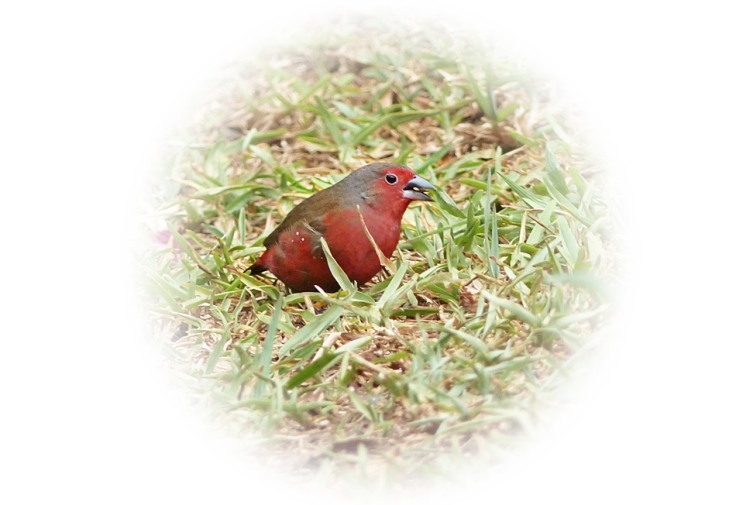
Posted by Carol

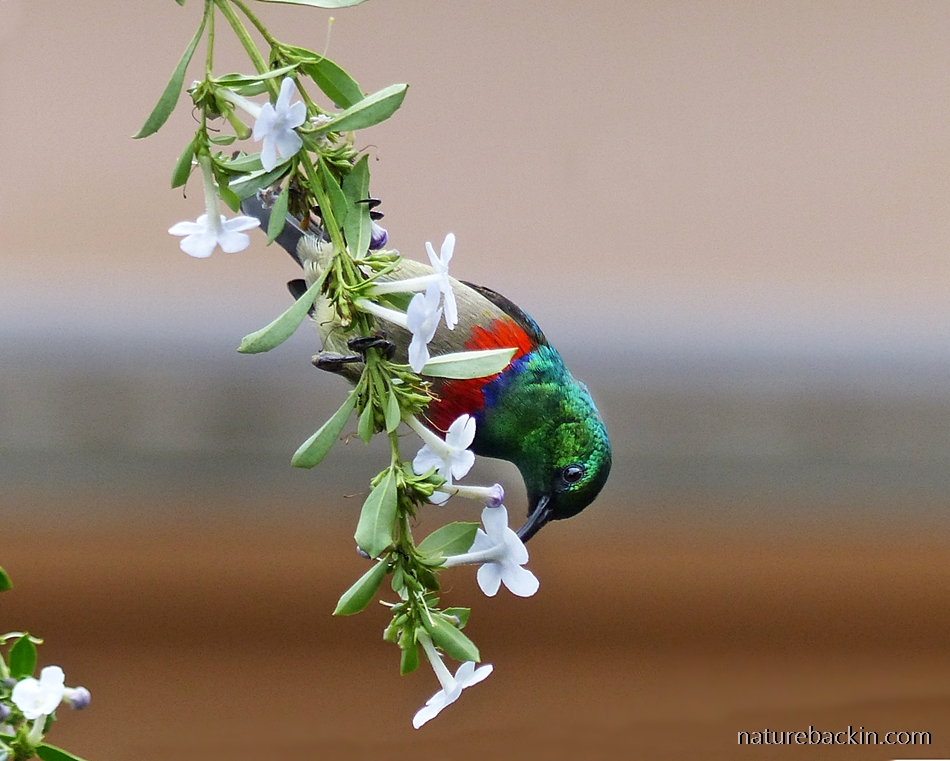




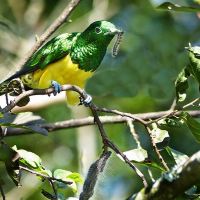
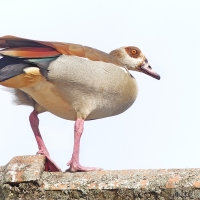

March 6, 2020 at 6:12 am
This was an incredible read with so much of insight! check out my blog too. I think we share common stories!
LikeLike
March 6, 2020 at 9:08 pm
Thank you Sherry. I have had a quick look at your blog and I am now following. I hope to be able to spend more time reading your interesting and sympathetic posts. Happy that we have connected.
LikeLike
November 5, 2019 at 9:08 am
Thank you for showing us this entrancing world in your garden through your camera lens. It is mesmerising. I also found it comforting after a 400 km round trip through the Eastern Cape and Karoo where we saw with our own eyes the devastating dryness that has blasted the land
LikeLiked by 1 person
November 7, 2019 at 8:55 pm
Thanks Mariss and nice that it provided some sense of comfort. You are right the land does look blasted – I found it hard to believe even when it was right before my eyes.
LikeLiked by 1 person
November 3, 2019 at 1:04 pm
Good advice.
LikeLiked by 1 person
November 7, 2019 at 8:51 pm
Thanks Nikki.
LikeLike
November 1, 2019 at 1:33 pm
Always a joy to read your articles.Carol. Yes, every one of us can do his own bit to help all creatures small and big
.
LikeLike
November 1, 2019 at 8:09 am
I wish you a nice holiday despite all these negative facts. But I think that life is strong and will survive! And we can all do something, as you show in your wonderful post!
LikeLiked by 1 person
November 7, 2019 at 8:49 pm
Thank you Simone 🙂
LikeLike
November 1, 2019 at 7:40 am
You will be relieved to know that the past week has been overcast with very light showers. Not enough rain. Plus we had an earth tremor yesterday.
LikeLiked by 1 person
November 7, 2019 at 8:49 pm
I believe that earth tremor was quite something! It is a relief there has been some rain, and now the prospect of some more 🙂
LikeLike
November 1, 2019 at 2:22 am
How appalling to hear of the severe circumstances of your region’s drought. We seem to be approaching drought problems as well, though luckily not as serious as what you describe… so far. It’s unnerving how quickly some of the predictions by scientists are happening. While our neighboring state (California) seems to be covered in wildfires.
LikeLiked by 1 person
November 7, 2019 at 8:46 pm
I agree it really is unnerving.
LikeLike
November 1, 2019 at 2:17 am
Your indigenous garden really is a fully fledged ecosystem, Carol, and if your example could only be emulated more widely we’d be well on our way to healthy urban biomes!
The scarcity of water all over South Africa still seems not to be grasped by so many of our countrymen. We already have quite severe water restrictions here in Pretoria, and yet you wouldn’t think so driving through the more affluent suburbs and business parks, where sprinklers running for hours seem the order of the day…
LikeLiked by 1 person
November 7, 2019 at 8:16 pm
It would be great if more people planted more sustainably and to benefit wildlife.
I also find it hard to understand how people can use water so wastefully especially in times of crisis. I had not realised that Pretoria had severe water restrictions, but I have since been reading a bit about the constraints on the Vaal water system. Unbelievable how the entire system is under such stress and how many feeder dams are so low.
LikeLiked by 1 person
October 31, 2019 at 11:46 pm
Yikes. Those stories about the drought are very sobering. We heard about the Cape Town crisis, but nothing about this drought in the mainstream news here in the U.S. Not that the powers that be would do anything; they’re too busy yelling at each other like 5-year-olds.
I’m glad that your garden is something of an oasis for wildlife and your photos are, as always, beautiful, especially the kingfisher photo. That’s quite the capture.
LikeLiked by 1 person
November 7, 2019 at 8:12 pm
Even here the drought has not had as much media coverage as it should. Once the Cape Town emergency was mitigated it ceased to be news, although water usage restrictions remain in place even in Cape Town.
U.S. news about the powers that be is certainly not encouraging.
We are so fortunate to have had some rain here, and this week we have had some really decent falls of rain, which is just wonderful even if localized. I also like the kingfisher photo – thanks.
LikeLiked by 1 person
October 31, 2019 at 6:16 pm
An excellent message – as always. I cannot help feeling a little envious at the largess your garden can still provide. There has been no rain here for so long that we have had no buds, flowers or even what might be regarded as weeds growing in the garden since last summer. The media coverage on the drought is very sobering and reminds me that the Eastern Cape are not the only ones suffering. Boreholes are fine for emergency measures but are not long term solutions. I am hoping that the national and local governments will at last turn their attention towards clearing aliens from river courses, stop the filling in of natural vleis and will – at last – oversea the fixing of crumbling infrastructure in our towns and cities that will see the end of leaks. We cannot afford to lose water at the rate we are all over the country.
LikeLiked by 1 person
November 7, 2019 at 8:08 pm
Despite travelling through parts of the dry Eastern Cape and Karoo I still can’t really grasp what it must be like to live with that as a daily reality with no prospects of real rain or relief. It was shocking to see plants that usually cope with aridity dying or dead. It must be so difficult not to become totally despondent when you see so little prospect for growth in your garden.
I agree with all you say, and its true that boreholes are an emergency short-term measure only. Infrastructure problems and the pollution and neglect of our rivers and water sources seriously impact on water scarcity, making a bad situation a lot worse. Water is such a basic resource that we have tended to take for granted. The problems are so immense and can seem overwhelming.
LikeLike
October 31, 2019 at 5:32 pm
An excellent post with an important message, Carol. Your ending is very sobering, a reality that is hard to grasp. The climate situation globally is becoming increasingly desperate. Scary, indeed. I hope you’ll be able to salvage your holiday.
LikeLiked by 1 person
November 7, 2019 at 7:59 pm
Thanks Eliza. It is scary.
Our holiday was interesting even though witnessing the ongoing drought – albeit superficially- was sobering and at times shocking.
LikeLiked by 1 person
October 31, 2019 at 5:10 pm
Bittersweet post , 🍃eco
LikeLiked by 1 person
November 7, 2019 at 7:56 pm
Thanks – yes that describes the dichotomies well.
LikeLiked by 1 person
October 31, 2019 at 5:04 pm
Your photos and text describe a world so different from ours in the UK. We are in full-autumn mode just now, so of course it’s a good time for creatures seeking grains, fruits, berries and indeed insects. That will soon change of course. But one thing we aren’t suffering from is drought. Anything but. Many sites are waterlogged, even flooded. So we’ll have to see what effect this has as winter draws in. So far, it’s fungi that actively appreciate these damp conditions.
LikeLiked by 1 person
November 7, 2019 at 7:54 pm
Absolutely they are different worlds and not just because the seasons are different. I hope your rain moderates and you have less mud this autumn and winter.
Are the fungi of the outdoor varieties only or are there also the dreaded indoor moulds?
LikeLiked by 1 person
November 9, 2019 at 8:26 am
We don’t do indoor moulds too much, even though our house is old. They find their homes in rented accommodation with unscrupulous landlords 😦
LikeLiked by 1 person
November 11, 2019 at 8:20 pm
Glad to hear you don’t get indoor moulds.
LikeLike